From the horizons of Kashmir Valley, unique styles are devised. The huge collection of styles including Cashmere Wraps, Cashmere Scarves, and Pashmina Shawls are present in the cradle of Kashmir. When the finest Cashmere from Ladakh is brought to the valley of Kashmir, an aura of Pashmina Art befits the legacy of craft. Among diverse styles of Pashmina Art, the designed form of Pashmina Shawls is curated by artisans. The Hand Embroidered Pashmina Shawls are one of a kind. The intricate needle works and threadworks cater to all the fashionistas around the world. The luxurious presence of Pashmina Art in each masterpiece of Hand embroidered Pashmina Shawl glorifies the wearer. Now the question arises, How to elegantly wear Embroidered Pashmina Shawl?
We have made a list of ways by which one can wear the luxurious Pashmina Shawl. Before that, we need to look over its meticulous creation and the saga of its journey to the contemporary age.
The Tale of Pashmina Art
It all started when a Persian saint was traveling across the globe. Mir Syed Ali Hamdani was a sage from the Middle East. The footprints of a saint Mir Syed Ali Hamdani from the middle east came to Kashmir with 700 craftsmen to adorn the beauty of the valley and to spread the holy message. He rested his feet in the region of Changhthanghi Ladakh. Thus, the saint landed its appearance in the Changhthangi Mountain in Ladakh. While perceiving nature, he locked his eyes on the Goat of marvelous wool. Awestruck with the softness and fineness of the wool, he made socks out of it and gifted them to the Sultan Zain-ul-Abideen of Kashmir Valley. Perceiving the beauty of Cashmere wool, suggested making an industry that cultivates the Pashmina in desirable styles. Even the name Pashmina, derived from the Persian word, pashm, meaning "the soft gold" is exquisite in being.
The Inception of the finest Cashmere
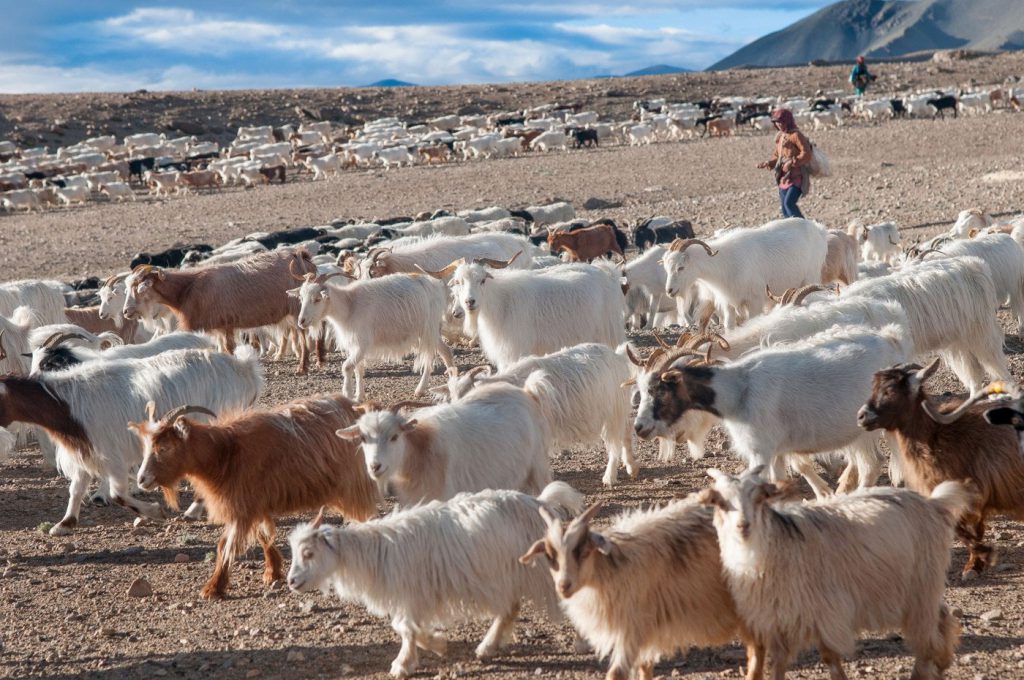
It all begins in the Changhthanghi mountain of the Ladakh region. The temperature goes to the minimum in this region. A rare breed of goats dwells in the region. These goats are called Changra goats. They are also called Cashmere Goats. The goats develop a pelage of wool in the winter season to combat the harsh weather. Thereafter, in summer they shed off the wool to get the air. The wool is manually combed out by the herders of the Changpa tribe. The Changpa tribe mainly raises these medium-sized Changra goats with two twisted horns. They mainly raise them for wool production. Thus, the wool is called the finest Cashmere wool.
There are diverse breeds of Cashmere producing goats. Each breed has a specific percentage of production in the total production. The several breeds viz; Australian Cashmere Goat, Liaoning, Inner Mongolia, Xinjiang, Hexi, Zhonghwei, Tibetan Plateau, Luliang breeds, Changthanghi, etc. Therefore, all the breeds produce Cashmere wool that produces warmth. The exclusive breed of goats called Changra Goats is rare species of goats
In addition, the Goats produce fine Cashmere wool once every year. Therefore, only around 80 to 170 gms of Ladakhi Cashmere are produced during a year. Therefore, considered the rarest. Also, other breeds of it produce several times more as there is almost 400 million Cashmere eliciting Goats all over the world. Consequently, the production caters to the manufacture of different styles like Pashmina Shawls, Cashmere Scarves, and Cashmere Wraps.
The Crafting of the finest Cashmere
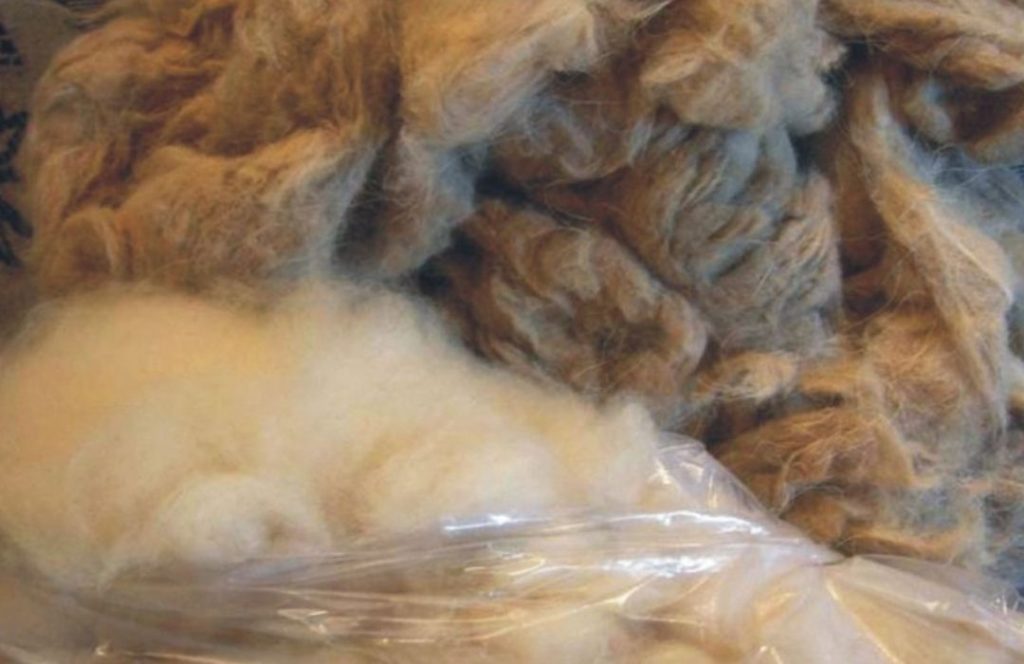
Although there are several breeds of goats all over the world that produce Cashmere. But the finest Cashmere is produced by the Ladakhi Changra goats. In order to curate the fine accessories from the fine Cashmere wool, the tufts of wool are taken to the Kashmir Valley. After the tufts of wool reach the valley of Kashmir, the supremely premium Art of Pashmina is commenced. It is a stepwise procedure of curating fine Cashmere accessories.
The foremost step is cleaning the Cashmere wool. There is a thorough cleaning of the wool to get all sorts of dirt out. After the process of cleaning, the next step is the process of Spinning. It begins by giving the local women the Cashmere wool to spin it fine Cashmere yarn. The womenfolk of the valley mainly spin Cashmere wool. The process is done on the wooden wheel/ charkha called yinder in the local language. Thus, the women artisans meticulously spin the Cashmere wool to the miraculously fine Cashmere yarn.
Weaving and Designing of Embroidered Pashmina
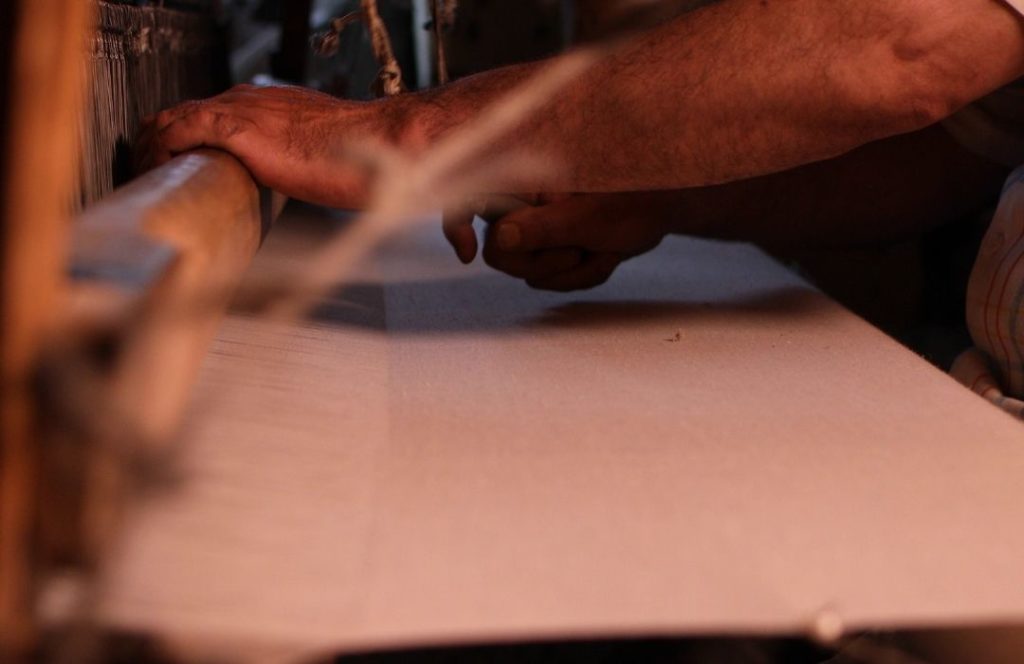
Afterward, the spun Cashmere yarn is taken to the local workshops/karkhanas to move ahead in the Pashmina Art. The next process is the weaving process. The weaving is the transformation of Cashmere yarn to fine Cashmere fabric. The intricate warps and wefts create the beautiful woven Cashmere fabric. Therefore, the most common pattern in weave is chashm_e_bulbul or the diamond weave. The weave is exclusively the masterpiece in itself. The eloquently woven Cashmere fabric goes on to further design.
The diverse designs, patterns, weaves, and embroideries are further done on the Cashmere. The premium Pashmina Art steps ahead with the most explicit and intricate designs. It is to be noted that all the steps in the Art of Pashmina are manually done by the artisans of Kashmir. Thus, the distinct designs cater to a diversity of people and the fashion world.
Today's generation feels the aura of authentic Cashmere in their lifestyles. This proves that not only the royals but also the people of admiration for Pashmina wear the new class Pashmina Shawls. In the contemporary world of fashion, the premium Pashmina Shawls prove to be the confidante of authenticity.
The diverse designs in the style of these Shawls create a sense of luxury upon the wearer. Further, the heritage, culture, and skill of the artisans profuse a dimension of glory in each masterpiece. Therefore, in one or another way, Pashmina Shawls confers premium luxury to both men and women.
The Hand-Embroidered Pashmina Shawls
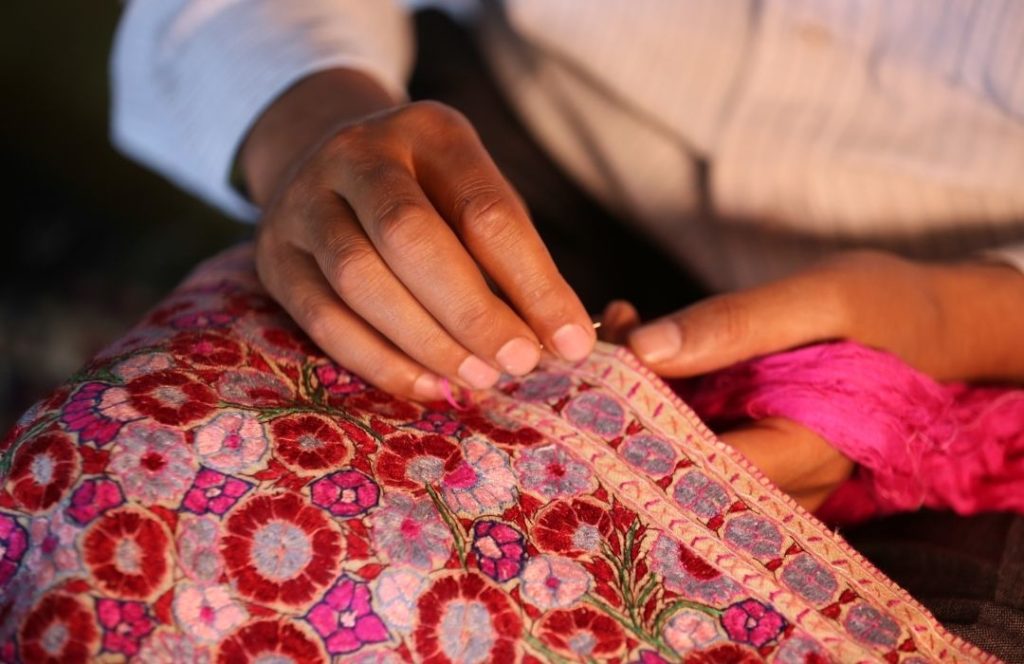
Embroidered Pashmina is the oldest Craft in the valley of Kashmir. Moreover, the craft has its heritage in the aura of the valley. Kashmir has been the sole region where the craft of embroidered Pashmina is excelled to its height from the 16th century. Moreover, Pashmina Craft has been cherished in the valley for ages. With the growing eras, the craft gleamed in many forms and diverse styles. As we know, it takes all the artistic greatness of skill of Kashmir's weavers, artisans, embroidered, dyers called Rangur, spinners, and designers to make the artwork of Pashmina imbibe all the intricacy and beauty.
There are diverse Hand embroideries viz; Sozni, Tilla Dozi, Aari, Papier Mache, Aksi. Moreover, there are specific motifs and designs that adorn the traditions of the valley reviving heritage in every masterpiece of Pashmina. The designs like; Dor dar/ Neem dar, Buta/ Buti, Hashi, Jalli, Jamawar, and Palla. Also, there are many motifs of flowers, nature, stories of heritage, and the most traditional Paisley. The foremost step after the weaving is to make the imprints by using hand blocks. The designs are imprinted over the wooden blocks for carving by Nakash/designer. In other words, based on the design, a wooden block is carved by a woodcarver diligently specializing in the designs of Embroidered Pashmina Shawls. He engraves the designs on a wooden block. Therefore, a very intricately carved walnut wood block lays the base for the Embroidered Pashmina Shawl.
Types of Hand Embroideries in Pashmina Craft
Skilled artists turn fragile Cashmere fabric into stunning wearable artwork through the highly esteemed art of hand stitching in Pashmina craft. Each stitch in this generation-old technique tells a tale of workmanship, legacy, and culture. It blends patience and perfection. Sozni, Tilla, and Aari are three of the most well-known needlework designs. Silk or woolen thread is used to delicately trace the contours of the Pashmina in Sozni embroidery, which is often done with a fine needle and has elaborate floral and paisley designs that resemble paintings on fabric. The shawl is a visual and physical treat because of the needle's delicate touch, which guarantees that the Pashmina's softness is never compromised.
Pashmina shawls are given a regal touch by tilla work, a sort of zari embroidery utilizing metallic threads. The shawl has an extravagant appeal due to its glistening gold and silver strands, which were once worn by royalty. In the meantime, the Aari embroidery, which is done with a hooked needle, produces a chain-stitch look that gives the patterns depth and texture. One craftsman may spend months working on a single shawl due to the time-consuming nature of the embroidery method. These embroideries are priceless keepsakes that are ageless because of the artisan's talent, the time-honored techniques, and the cultural value of each item.
Hand-embroidered Pashmina shawls are a celebration of tradition, not just style. Every thread relates a tale of the crossroads between Persian, Mughal, and indigenous cultures in Kashmir. With floral arrangements possibly signifying prosperity and paisleys representing eternity, the thoughtful arrangement of motifs alludes to traditional iconography. These embroidery pieces serve as more than just accent pieces; they are a link between generations, conserving methods and histories that are just as priceless as the shawls themselves. Hand-embroidered Pashminas provide a rare, patient luxury in a world that prioritizes speed—where beauty is a product of human hand, tradition, and patience.
Sozni Hand-Embroidery
The exquisite refinement and painstaking detail of Sozni hand-embroidery are well-known, and it is considered a hallmark of Kashmiri workmanship. Using a tiny needle and this stitching method, you can turn fine Cashmere fabric into a work of art by creating beautiful designs on it. The shawl's motifs, which are usually nature-inspired, include graceful vines, flowers, and paisleys that flow in a pleasing pattern. Craftsmen in Sozni work take great care in every stitch; to attain the required intricacy, they may work on a single shawl for months or even years. With the thread subtly integrating into the Pashmina, giving texture without sacrificing its softness, the finest Sozni work looks as though it has been painted onto the cloth.
The double-sided stitch, in which the design on the front is precisely replicated on the back, is the most distinctive feature of Sozni embroidery and showcases the artist's unparalleled accuracy and expertise. The embroidery, which is frequently done in wool or silk thread, has a kaleidoscope of hues that shimmer as the light touches the minute details of the threads. For the tiniest details, artisans employ just one strand of thread, producing intricate designs that resemble filigree. Concentration and patience are essential for this double-sided work since every stitch must to line up precisely. Historically, Sozni needlework has been used to adorn Pashmina shawls given to nobility and royalty, signifying their social standing and taste in fashion.
Sozni needlework has great cultural value in addition to being aesthetically pleasing. With floral themes signifying fertility, abundance, and regeneration and paisleys, a Persian symbol for immortality, connected to ideas of life and rebirth, the patterns frequently capture the natural beauty of Kashmir's surroundings. The art itself is a cultural legacy that has been passed down through the years, safeguarding the rich artistic legacy of the area. A Sozni-embroidered Pashmina is a celebration of history, art, and the human touch that keeps this centuries-old tradition alive.
Aari Hand Embroidery
The centuries-old Aari hand embroidery method adds texture and depth to Pashmina and other fine textiles with its distinctive chain-stitch design. By looping the thread quickly after one another with a specialized hooked needle, artists make a continuous sequence of tiny, connected stitches that create beautiful motifs. With this technique, intricate patterns that are influenced by Kashmir's rich culture and verdant landscapes can be produced, ranging from intricate geometric shapes to dense floral themes. Aari work is highly valued because of its rich, textured appearance, which contrasts with Pashmina's smooth, velvety surface. The shawl gains a tactile dimension and visual richness from the raised designs, making it a true work of wearable art.
Aari embroidery's boldness and adaptability are what make it so beautiful. While Sozni's work is renowned for its exquisite, painterly details, Aari stands out for its capacity to cover huge surfaces with intricate, eye-catching patterns. The fabric can take on a dazzling, regal appearance when embroidered with metallic threads like zari, which are occasionally used in addition to silk, cotton, or wool threads. Craftsmen can produce consistent, flowing designs that repeat rhythmically throughout the shawl with ease because to the hook needle. Aari art produces a visual rhythm that gives the item movement and vitality, whether it is through the symmetry of paisleys or the elaborate spread of leaves and flowers.
Aari needlework has cultural and historical significance in addition to its aesthetic value. The Mughal era saw the beginning of this skill, which was originally employed to embellish royal clothing with motifs that frequently represented wealth, power, and beauty. This method preserved the artistic heritage of the area and eventually became a distinguishing feature of Kashmiri textiles. Aari embroidery, like other handicrafts, is a labor-intensive procedure that showcases the talent and commitment of the artists, many of whom have been practicing their craft for generations. having an Aari-embroidered Pashmina today signifies accepting a piece of cultural legacy that has endured the test of time and providing timeless beauty and craftsmanship in every stitch, rather than simply having a nice accessory.
Tilla Hand Embroidery
One of the most lavish and majestic types of needlework is Tilla hand embroidery, sometimes referred to as Tilla Dozi, and is typically connected with Kashmiri Pashmina shawls and clothing. In this hobby, metallic threads are used to create elaborate, shimmering designs on cloth. The most common metallic colors used are gold and silver, but copper and other metallic tones can also be utilized. Tilla needlework, which has its origins in the Mughal courts, was originally only worn by royalty and nobility to add a sense of grandeur to their ceremonial gowns and shawls. The Pashmina's velvety, matte texture contrasts with an opulent, radiant impression created by the exquisite way the metallic threads catch the light. The designs, which frequently include geometric shapes, paisleys, and floral motifs, give the fabric a refined, luxurious look, making Tilla-embroidered shawls and clothing opulent.
Tilla needlework is a labor- and time-intensive process that needs the steady hand of an experienced artisan. A fine needle is used to carefully stitch the metallic threads—which might be thick and quite stiff—into the fabric. Because the threads are reflecting, artisanal work must be meticulous to ensure that the patterns are smooth and homogeneous. The distinctive raised texture of Tilla embroidery, which contrasts sharply with the Pashmina foundation to give the item a three-dimensional appearance, distinguishes it from other techniques. Modern Tilla patterns have included finer, more delicate motifs that keep the craft's distinctive elegance while appealing to current tastes. Traditionally, Tilla designs were generally bold and enormous.
Tilla needlework has great cultural value in addition to being aesthetically pleasing; in Kashmir, for example, it is frequently used to adorn bridal gowns and festival clothing. Tilla-embroidered items are prized relics that are handed down through the centuries because of the dazzling metallic threads, which are seen as symbols of festivity, wealth, and elegance. Every Tilla creation is a testament to Kashmir's ongoing cultural legacy as well as a tradition of skillful workmanship. In order to keep this age-old skill valuable and relevant in the current world, designers and craftspeople continue to love embroidery. They accomplish this by fusing classic motifs with contemporary interpretations. More than just a fancy outfit, owning a Tilla-embroidered pashmina connects you to the past and its history, culture, and artistic talent.
Diverse Ways to wear an Embroidered Pashmina Shawl
1. The Side shoulder look
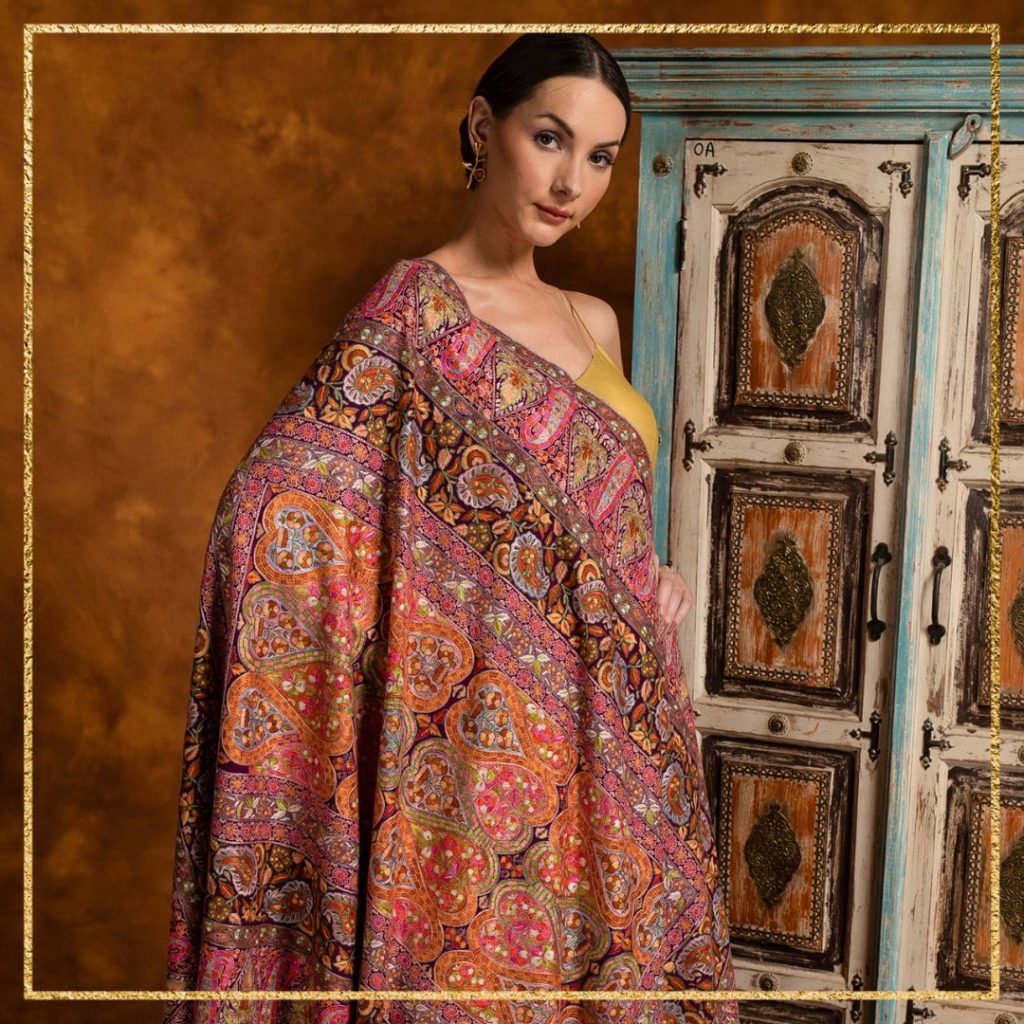
This is the most simple yet elegant look in the Pashmina world. All you have to do is take your exquisite Embroidered Pashmina Shawl and drape it on one of your shoulders. It is to be noted that the front side should be longer and the other back side can be shorter. Therefore, the look goes well with traditional attires, occasional apparel, and even casuals. The look presents the unique dimensions of the Pashmina Shawl.
2. The Shroud of Embroidered Pashmina Shawl
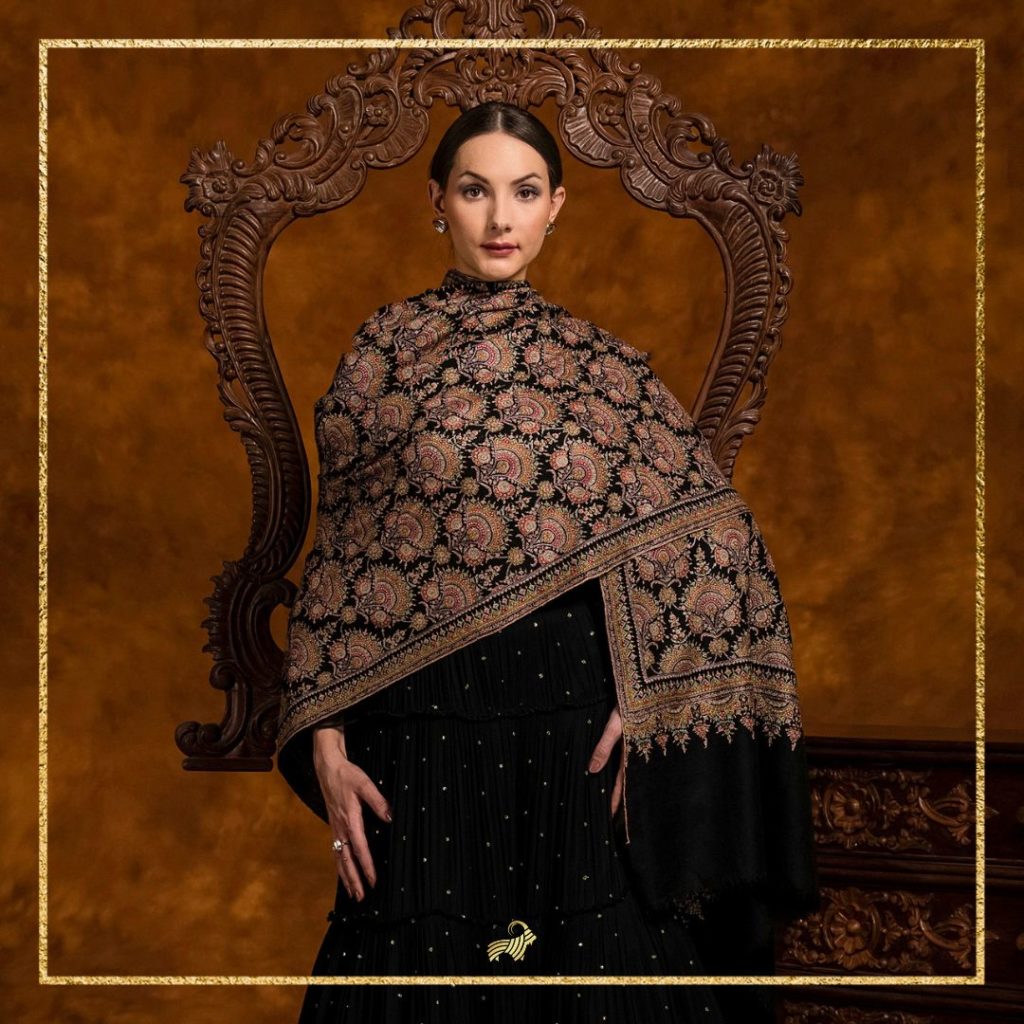
The look is very basic. The glamour of this look goes to the horizons of traditions. Just take your Pashmina Shawl and drape it around your whole upper body. Thus, covering arms, shoulders, and neck. The look keeps you warm in cold seasons. In addition, the look adds glory to the luxurious Embroidered Pashmina Shawl. This presentation goes well with casuals, traditional attires, and wedding apparel. Also, this look caters to all genders.
3. The Head whirl
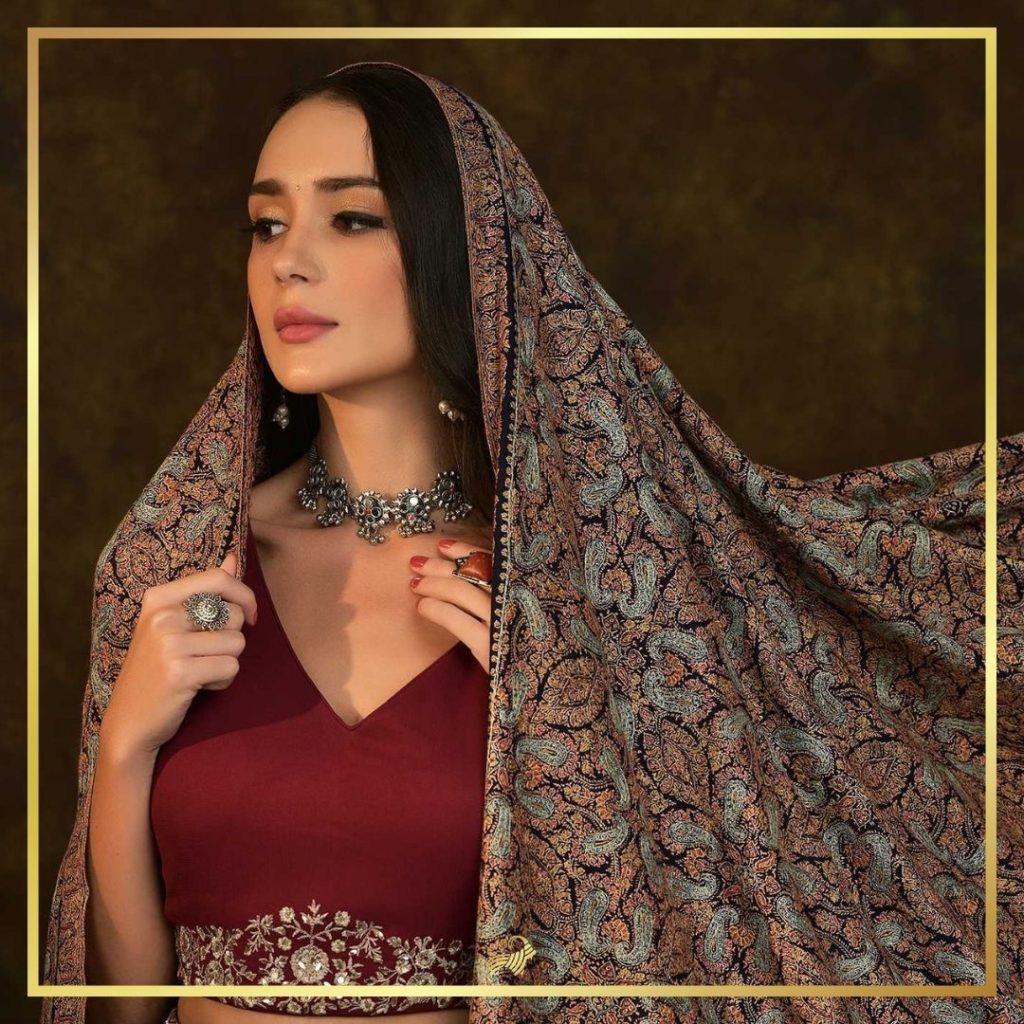
This look is extraordinarily the most intricate look. All you have to do is take your Embroidered Pashmina Shawl and drape it around your head as well as your shoulders. The whole drape will cover your entire upper body including the head. The look is so traditional and enthralling that it goes well with wedding apparel and to casuals on a cold day. The exquisite look enhances your presence with luxury.
4. The Turban of luxury
The look is exclusive to men but it can be worn by women folk also. The look will give boldness to women with an explicit Pashmina shawl. Just take the Pashmina Shawl and drape it around your head in multiple layers. Afterward, take the end and fold it into one of the layers. The look is traditional as well as classy in its own way. Thus, present your apparel with this marvelous look.
5. The Classy Toss
This look is the most simple look. All you have to do is take the Embroidered Pashmina Shawl and drape it around your neck in such a way that the two loose ends in front are at different lengths. Then, take the longer end and toss it to the opposite shoulder. Here is your go-to look for casuals, formals, and occasional attires. The look amplifies the uniqueness of each Embroidered Pashmina Shawl in its own way. The look confers to both men and women.
6. The Front Drape
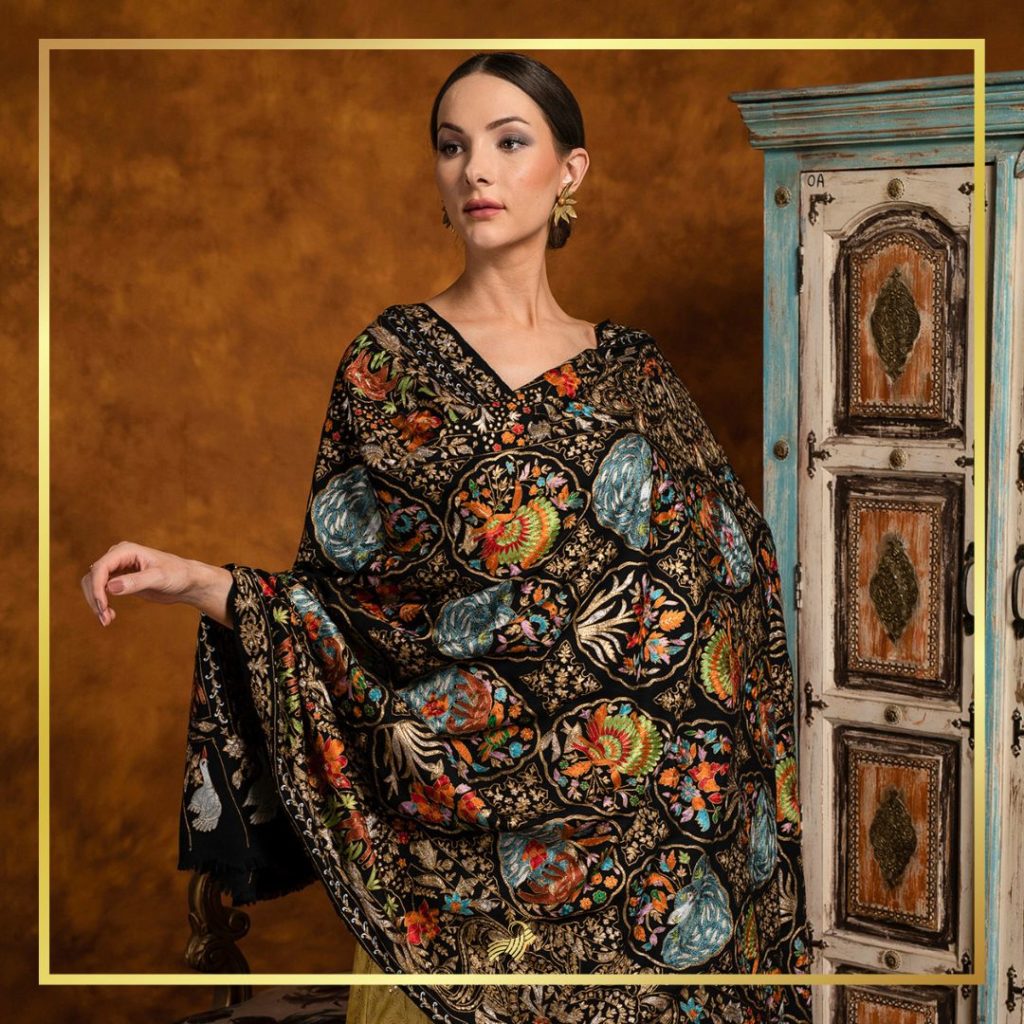
All you have to do is take your Pashmina shawl and throw it over your front upper body and let stay on your shoulders. This is the classy look for women. The beauty of this look is that it is simple and it elegantly showcases the supreme Embroidery of your premium Pashmina Shawl.
Also read: PASHMINA SHAWLS TO ADORN ON ANY OCCASION
Pashmina Art Collection
We, at pashmina.com, confer on the unique styles of Pashmina Art. The diverse collection belongs to the artisans of high skill. The artisans work meticulously with supremely finest Cashmere. Thus, creating distinct accessories in the sphere of Kashmir Valley. Having one of the masterpieces of Pashmina Art will cater to your beauty with a unique style of the finest Cashmere. Thus, the versatile definition of Pashmina Art is seen in each and every masterpiece of accessories.
Also read: WOMEN EMPOWERMENT - GI PASHMINA SHAWLS